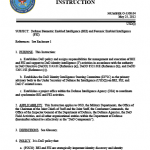The Department of Defense (DoD) performs forensic science in a collaborative environment which necessitates the clear communication of all activities and their results. A critical enabler of communication is the use of a clear, internally consistent vocabulary. The goal of the Department of Defense Forensics Lexicon is to provide an operational vocabulary to address Forensics. A shared vocabulary enables a common understanding of Forensics, enhances the fidelity and the utility of operational reporting, facilitates structured data sharing, and strengthens the decision making processes across the DoD.
Tag Archive for Biometrics
International Criminal Police Organization
INTERPOL Facial Images Best Practices Guide
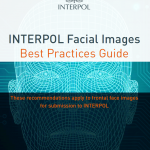
The purpose of this document is to recommend a simple set up for taking frontal face (mugshot) images. Different cameras will obviously produce different results but there are other important factors to take into consideration which can have a big impact on the effectiveness of facial recognition software.
Department of Defense
(U//FOUO) DoD Biometrics Capstone Concept of Operations
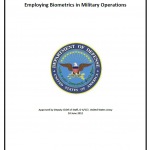
A biometric is a measurable physical characteristic or personal behavior trait used to recognize the identity or verify the claimed identity of an individual. Fingerprints are an example of a physical biometric characteristic. Behavioral biometric characteristics like handwriting are learned and acquired over time. Biometrics is the process of recognizing an individual based on measurable anatomical, physiological and behavioral characteristics. Employing biometrics can help positively identify adversaries, allies and neutral persons. This is particularly useful when facing adversaries who rely on anonymity to operate. Biometrics is not forensics even though the two can, and often are, employed in concert. Forensics involves the use of scientific analysis to link people, places, things and events while biometrics involves the use of automated processes to identify people based on their personal traits. Because of the interrelationship between biometrics and forensics, the Department of Defense (DOD) intends to develop a single concept of operation (CONOP) in the future describing how biometrics and forensics can be employed in a complementary manner.
Federal Bureau of Investigation
FBI Mobile Biometric Application Request for Quotations
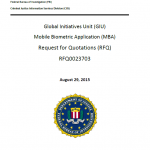
The Criminal Justice Information Services (CJIS) Division’s Quick Capture Platform (QCP) is a state-of-the-art biometric system that enables investigators to collect and store fingerprint data during domestic and international investigations. The QCP enables instant access to federal fingerprint databases. This comprehensive access to the main United States (U.S.) Government biometric holdings enables QCP users to quickly establish whether a subject has possible terrorist links (in the U.S. or abroad) or is likely to pose a threat to the U.S.
California
San Diego Regional Facial Recognition System Policy
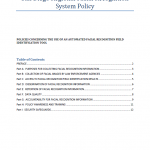
These policies are intended to provide law enforcement agencies uniform guidance regarding their appropriate use of a facial recognition field identification tool. Nlets sponsored the preparation of its Privacy Impact Assessment Report for the Utilization of Facial Recognition Technologies to Identify Subjects in the Field to better describe the privacy issues surrounding law enforcement agencies’ utilization of facial recognition technologies in the field. These policies were generated in response to the discussions contained in that report.
Federal Bureau of Investigation
FBI Biographic Entity Resolution Presentation
Corporate
International Biometrics and Identification Association Draft Privacy Best Practices for Commercial Biometrics
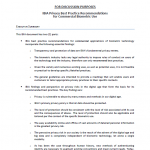
One fact should not be lost in this discussion. As has always been the case, new methods of authenticating identity, like biometric identification, are necessary to augment existing conventions and meet current needs. Biometric technologies do this and, as a major privacy‐enhancing technology, preserve privacy at the same time. The facial template itself, like other biometric templates, provides no personal information. Indeed, protecting the non‐biometric personal information is enhanced through the use of biometric verification of identity to limit data access to only authorized persons. Biometrics can provide a unique tool to protect and enhance both identity security and privacy and to protect against fraud and identity theft, especially as a factor in identity verification. When your personal data are protected by access mechanisms that include one or more biometric factors, it becomes much more difficult for someone else to gain access to your personal data and applications because no one else has your unique biometric attributes. This enables legitimate access and reduces the risk that a person can steal your identity and, posing as you, collect benefits; board an airplane; get a job; gain access to your personal data, etc.
Featured
Identity Dominance: The U.S. Military’s Biometric War in Afghanistan

For years the U.S. military has been waging a biometric war in Afghanistan, working to unravel the insurgent networks operating throughout the country by collecting the personal identifiers of large portions of the population. A restricted U.S. Army guide on the use of biometrics in Afghanistan obtained by Public Intelligence provides an inside look at this ongoing battle to identify the Afghan people.
Afghanistan, U.S. Army
(U//FOUO) U.S. Army Commander’s Guide to Biometrics in Afghanistan

Biometrics capabilities on the tactical battlefield enable a wide variety of defensive and offensive operations. Biometrics help ensure enemy personnel, criminals, and other undesirable elements are not allowed access to our facilities, hired to provide services, or awarded contracts. Biometrics is used to vet members of the Afghan government and military with whom our forces interact. Unfortunately, biometrics capabilities we put in the hands of Soldiers, Marines, Sailors, and Airmen — and that we ask unit commanders to employ — are relatively recent additions to the list of capabilities our military employs on the battlefield today.
U.S. Army
(U//FOUO) U.S. Army Unified Exploitation Concept of Operations 2012-2018

This CONOPS describes an overarching concept of operations for the 2012-2018 timeframe that provides a framework for “Unified Exploitation (UE)” operations and the basis to develop supporting capabilities. It establishes linkages to other Army concepts and describes how UE enables decisive action in support of unified land operations. This CONOPS describes the operational context and how commanders integrate supporting UE capabilities through Mission Command to produce an operational advantage. This CONOPS addresses the central military problem: the Army lacks a systematic approach to effectively integrate multiple organizations, disciplines, functions, and processes that support exploitation through their application of tactical, technical, and scientific capabilities. The absence of an organized exploitation framework to develop facts, actionable information or intelligence from collected enemy information, materials, or people, results in a knowledge void. This lack of knowledge may compromise our ability to execute commander directed, follow-on actions and represents tactical and perhaps even strategic opportunities lost.
News
The Nationwide Network Working to Bring Mobile Biometrics to Your Community

A federal law passed in February 2012 to help middle class families by creating jobs and cutting payroll taxes included a section mandating the creation of a nationwide interoperable broadband communications system for law enforcement and first responders. The system, which is being created under the direction of the First Responder Network Authority (FirstNet), seeks to create a nationwide broadband network capable of being used for a variety of law enforcement purposes including remote surveillance, mobile biometric applications like field fingerprint scanning and facial recognition, as well as automated license plate reading. The system is currently in a pilot phase with less than a dozen locations around the country participating in the initial rollout of the FirstNet network. However, comments from FirstNet board members indicate that the future goals of the system include an interoperable network operating in all 56 states and territories of the U.S. that is capable of integration at the state, local and federal level.
California
San Francisco Bay Area Regional Interoperable Communications Systems Authority (BayRICS) Facial Recognition Presentation
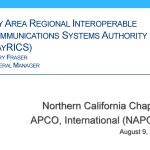
A presentation presenting an overview of the Bay Area Regional Interoperable Communications System Authority (BayRICS), a 13-member Joint Powers Authority (JPA) serving the San Francisco Bay Area, established in August 2011. The presentation lists license plate readers, facial recognition and field fingerprint scanning as potential uses of the BayRICS network.
U.S. Army
Restricted U.S. Army Special Forces Handbook for the Fingerprint Identification System

Special Forces (SF) Soldiers use various biometric identification systems in SF operations. Biometric applications are fundamental to a wide array of SF operational activities, including, but not limited to, the growing field of SF sensitive site exploitation (SSE) and the range of unit protection activities. SSE applications include the identification of enemy personnel and cell leaders in a counterinsurgency (COIN) environment following tactical operations, particularly during direct action missions. Unit protection applications include maintaining databases on the identities of both United States Government (USG) and local national personnel.
Federal Bureau of Investigation
FBI Next Generation Identification Video Presentations
Department of Energy
Sandia National Laboratories Mobile Biometric Device Technology Study
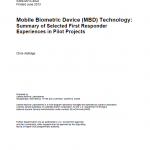
Mobile biometric devices (MBDs) capable of both enrolling individuals in databases and performing identification checks of subjects in the field are seen as an important capability for military, law enforcement, and homeland security operations. The technology is advancing rapidly. The Department of Homeland Security Science and Technology Directorate through an Interagency Agreement with Sandia sponsored a series of pilot projects to obtain information for the first responder law enforcement community on further identification of requirements for mobile biometric device technology. Working with 62 different jurisdictions, including components of the Department of Homeland Security, Sandia delivered a series of reports on user operation of state-of-the-art mobile biometric devices. These reports included feedback information on MBD usage in both operational and exercise scenarios. The findings and conclusions of the project address both the limitations and possibilities of MBD technology to improve operations. Evidence of these possibilities can be found in the adoption of this technology by many agencies today and the cooperation of several law enforcement agencies in both participating in the pilot efforts and sharing of information about their own experiences in efforts undertaken separately.
Federal Bureau of Investigation
(U//FOUO) FBI Next Generation Identification Overview July 2013
Department of Defense
(U//FOUO) DoD Instruction: Biometric Enabled Intelligence (BEI) and Forensic Enabled Intelligence (FEI)
Home Office
U.K. Home Office Draft Statutory Guidance on National Security Retention of Biometric Data
This guidance is to provide direction to any police force or other law enforcement authority regarding the retention and use of biometric material for national security purposes through the making or renewing of a national security determination.
Multi-National Corps Iraq, U.S. Marine Corps
(U//FOUO) Iraq Biometric Automated Toolset (BAT) HIIDE Standard Operating Procedures
Multi-National Forces West Biometric Automated Toolset (BAT) Handheld Interagency Identity Detection Equipment (HIIDE) SOP and TTP from June 2007.
Department of Homeland Security
DHS Social Network Analysis, Behavioral Threat Detection, Biometrics Presentation
DHS Human Factors/Behavioral Sciences Division presentation on social network analysis, behavioral threat detection and biometrics programs as of May 2009.
Department of Homeland Security
DHS Future Attribute Screening Technology Mobile Module (FAST M2) Overview
Overview presentation from 2007 regarding the Future Attribute Screening Technology Mobile Module (FAST M2), a system for identifying potential threats via behavioral analysis.
U.S. Army
(U//FOUO) U.S. Army Biometric Automated Toolset (BAT) Smart Card
U.S. Army Biometric Automated Toolset (BAT) Smart Card from February 2007.
Federal Bureau of Investigation
FBI Identification Division Fingerprint Training Manual July 1987
FOUO FBI Identification Division Fingerprint Training Manual from July 1987.
Corporate, Department of Defense
DoD Biometrics HIIDE Device User Guide
The HIIDE includes two separate cameras for imaging an individual’s irises and face, and a sensor pad for scanning fingerprints. These three sensors capture the minute details of a subject’s iris, fingerprint and face, as digital photographs, or “scans.” The HIIDE™ translates the photographic data into a binary code and links that code to biographic data about the individual, such as name and a personal identification number. The HIIDE then processes the code and biographic data and builds a portfolio for the individual that is stored in a database. Once an individual has had a record created, or has been “enrolled,” that individual is part of the HIIDE database. One can “recognize,” or confirm that individual’s identity in the future by comparing a live scan of the subjects: iris, fingerprints and/or face to the biometrics contained in the database.




